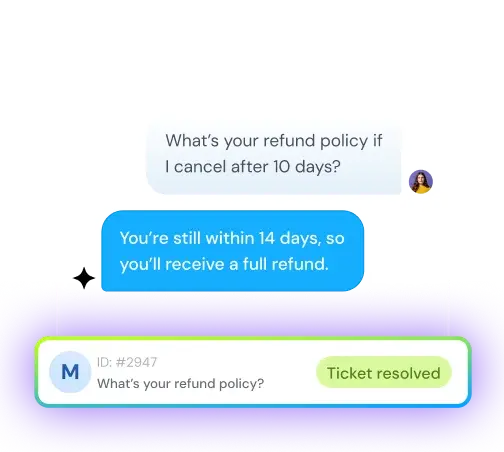What is customer service? The complete guide with strategies for 2025
May 24, 2025
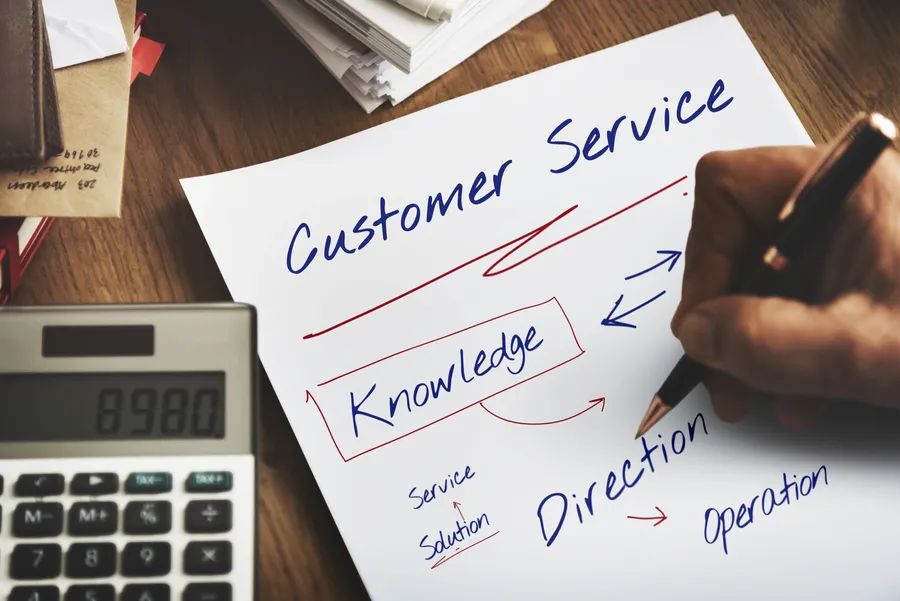
Did you know that 84% of customers prefer companies that personalize their customer service experience? Isn't that mind-blowing? That's almost your entire customer base willing to open their wallets just because you made them feel special!
Customer service isn't just about fixing problems anymore. It's become the secret sauce that determines whether your business thrives or nose-dives in 2025.
Here's the scary part - 61% of customers will jump ship to your competitors after just ONE bad experience [Hiver HQ]. That's a massive chunk of your revenue walking out the door because of a single negative interaction! The stakes have never been higher for understanding what great customer service truly means.
So, what exactly makes customer service tick in 2025? How can you turn your support team into revenue generators instead of cost centers? Let's find answers to all of these here.
Topics covered in this article:
- What customer service really means in 2025
- Why customer service directly impacts your bottom line
- Top strategies that deliver exceptional customer experiences
- Balancing human touch with technology
- Measuring success beyond basic satisfaction scores
- Building a customer-centric approach that drives growth
Customer service has transformed dramatically, and those who master it will leave competitors in the dust. Think of it as your business's immune system - when it's strong, everything else works better! Ready to build customer service that doesn't just solve problems but creates raving fans? Let's dive in.
What is customer service? The modern definition for 2025
So, what exactly is customer service that's causing such massive shifts in business success? In 2025, it's way more than answering questions or fixing problems. Customer service is the act of assisting and advocating for your customers before, during, and after the purchase of a product or service.
It covers every single interaction aimed at helping customers squeeze maximum value from what you offer, whether through human agents or self-service options like knowledge bases and AI Agents.
Great customer service isn't just slapping together hasty responses to tickets. It's about going the extra mile to solve customer problems with the absolute best solutions available. More than that, it's a strategic goldmine for building loyalty and pumping up your revenue growth.
The evolution of customer service over time
Customer service has gone through quite the transformation journey! Back in the day, it was purely reactive and totally business-centered, with support only available during those rigid 9-to-5 hours. Companies saw customer interactions as simple transactions that ended the moment money changed hands.
The evolution happened something like this:
- Industrial era: Face-to-face was king. Got a problem? Time to put on your shoes and physically visit a store
- Telephone era: Alexander Graham Bell's little invention changed everything, shifting service to voice-based help
- Digital revolution: Email, social media, and messaging platforms exploded, creating a multi-channel support universe
- AI-driven present: Now we're talking proactive, predictive support that sees problems before they even happen
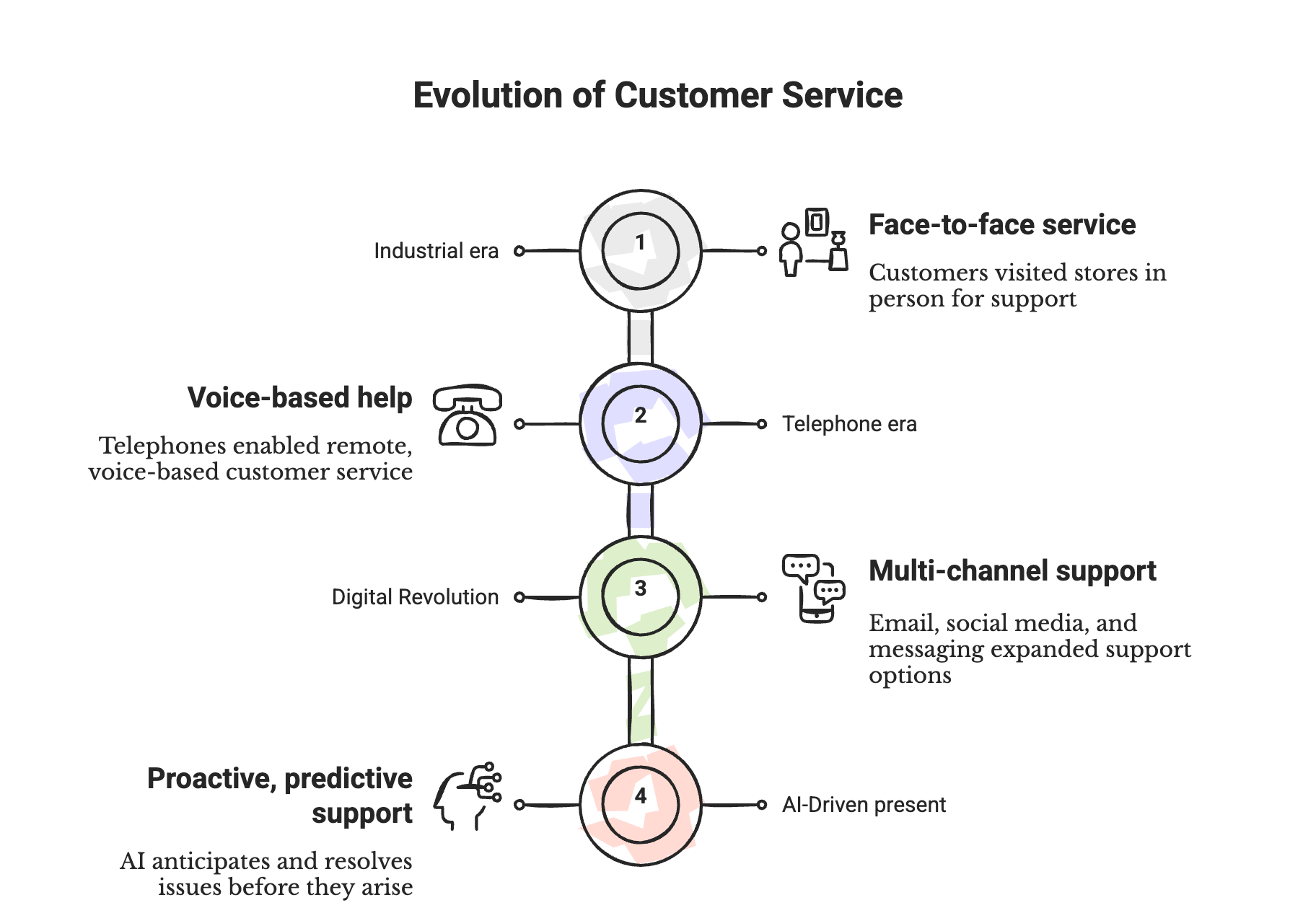
We've moved from customer service being just an after-purchase thing to becoming a proactive, customer-obsessed strategy that anticipates needs throughout the entire customer journey. That's a massive shift in thinking!
Core elements of customer service today
Modern customer service in 2025 is built on several key pillars that together create those jaw-dropping experiences customers rave about:
- Speed and responsiveness: 90% of customers think speed is the most critical component. Waiting feels like torture, doesn't it?
- Empathy and personalization: Nearly half of customers prefer agents who actually sound like they care. Who knew people like talking to other humans?
- Omnichannel accessibility: Support across phone, email, live chat, messaging apps, and every social platform under the sun
- Self-service options: Knowledge bases, chatbots, and AI Agents that let customers find answers without waiting on anyone
- Proactivity: Addressing potential issues before they explode, like Feed's smart practice of reaching out to customers about shipping changes before they even notice
Smart businesses understand that exceptional service needs both tech efficiency and human warmth. They provide lightning-fast responses while keeping conversations friendly and kind. They also meet customers where they already hang out, with 50% of customers preferring contact through platforms they use with loved ones, such as Facebook Messenger and WhatsApp.
How customer service differs from customer experience
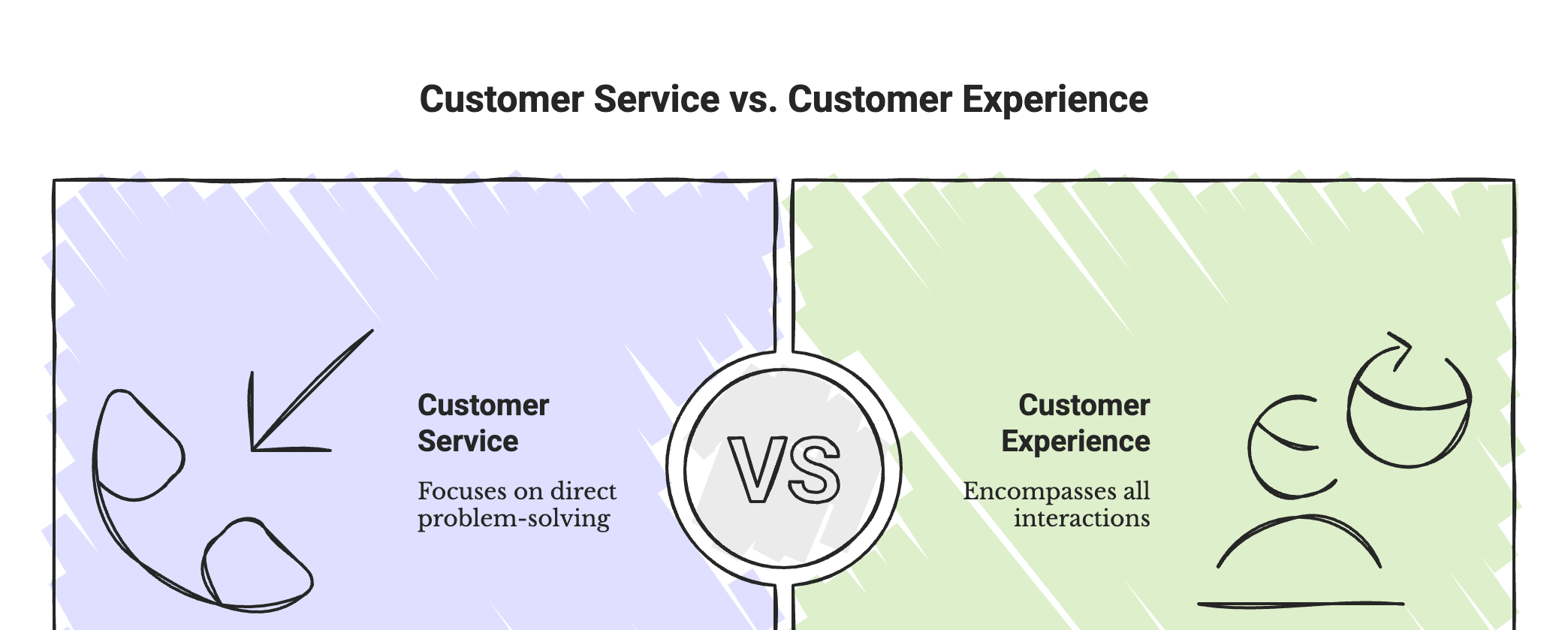
Customer service and customer experience (CX) might sound like twins, but they play different roles in your business strategy:
Customer service is just one touchpoint in the broader customer journey. It's all about those direct, one-on-one moments where you solve immediate problems or fulfill specific needs. Your company has total control over the service you provide, and it falls squarely on the shoulders of your support managers and agents.
Customer experience, on the other hand, is the whole enchilada—every single interaction, impression, and touchpoint combined into one big picture. As the Zendesk Customer Experience Trends Report points out, customer service is just one ingredient in the entire customer journey recipe.
Getting this distinction clear helps you align your customer service efforts with broader CX initiatives to build relationships that stick. Think of it as the secret sauce in your experience menu—mess it up, and the whole meal is ruined.
Why customer service matters: Business impact and importance
In the business world, your customer service team isn't just handling complaints—they're guarding your company's treasure chest. Behind every support interaction lies a financial opportunity or risk that directly affects your bottom line. In 2025, understanding what customer service means for business value has become more crucial than ever.
US companies lose $75 billion yearly due to poor customer service. That's a load of money down the drain! Given how competitive markets have become, recovering from service blunders isn't just difficult—it might be impossible.
Customer service doesn't just keep the lights on; it's the engine that drives sustainable growth. Think about it: every interaction is either building your bank account or emptying it. There's rarely any middle ground. When a customer reaches out with a problem, they're giving you a golden opportunity to either cement their loyalty or send them running to competitors.
The math is brutally simple. A happy customer tells 4-6 people about their experience. An unhappy one? They'll tell 9-15 people. And with social media, that unhappy customer might as well be shouting from a digital mountaintop to thousands.
Let’s take a car agency scenario. Someone makes a purchase, finds an issue with the brakes, and reaches out for help. The representative ignores it or blames the customer. Soon that frustration explodes across social media, and your brand reputation crumbles faster than a sandcastle at high tide. Prospective customers see this drama unfold and quietly decide to purchase the same car from your competitor instead.
That's the true price of poor customer service—not just the lost sale, but all the future sales that quietly disappear without you ever knowing why. Customer service isn't an expense; it's your strongest defense against competition.
Customer service as a competitive differentiator
In today's market where everyone's fighting for attention, exceptional service has become the ultimate standout factor. No matter what industry you're in, customers expect amazing experiences, with 61% dumping brands that don't deliver.
What makes this such a powerful advantage? First, customers will actually reward you for treating them well:
HubSpot research shows that 93% of customers are likely to make repeat purchases with companies that offer excellent customer service.—even if it means more hassle on their part. And get this—75% of customers wouldn't mind paying more just for friendly and welcoming interactions [Zendesk]. Who knew being nice could be so profitable?
The cost of poor customer service
The price tag for bad service will make your jaw drop. Globally, organizations risk losing $3.7 trillion annually due to bad customer experiences—a number that jumped by $600 billion (19%) from just last year. That's more than the GDP of most countries!
How does this financial bloodbath happen? After one negative experience, customers reduce or completely stop spending with that brand more than half the time. For fast food and package delivery, this number shoots up to over 60%. Yikes! And it gets worse—the damage multiplies through negative word-of-mouth, since unhappy customers are twice as likely to share their horror stories compared to positive experiences.
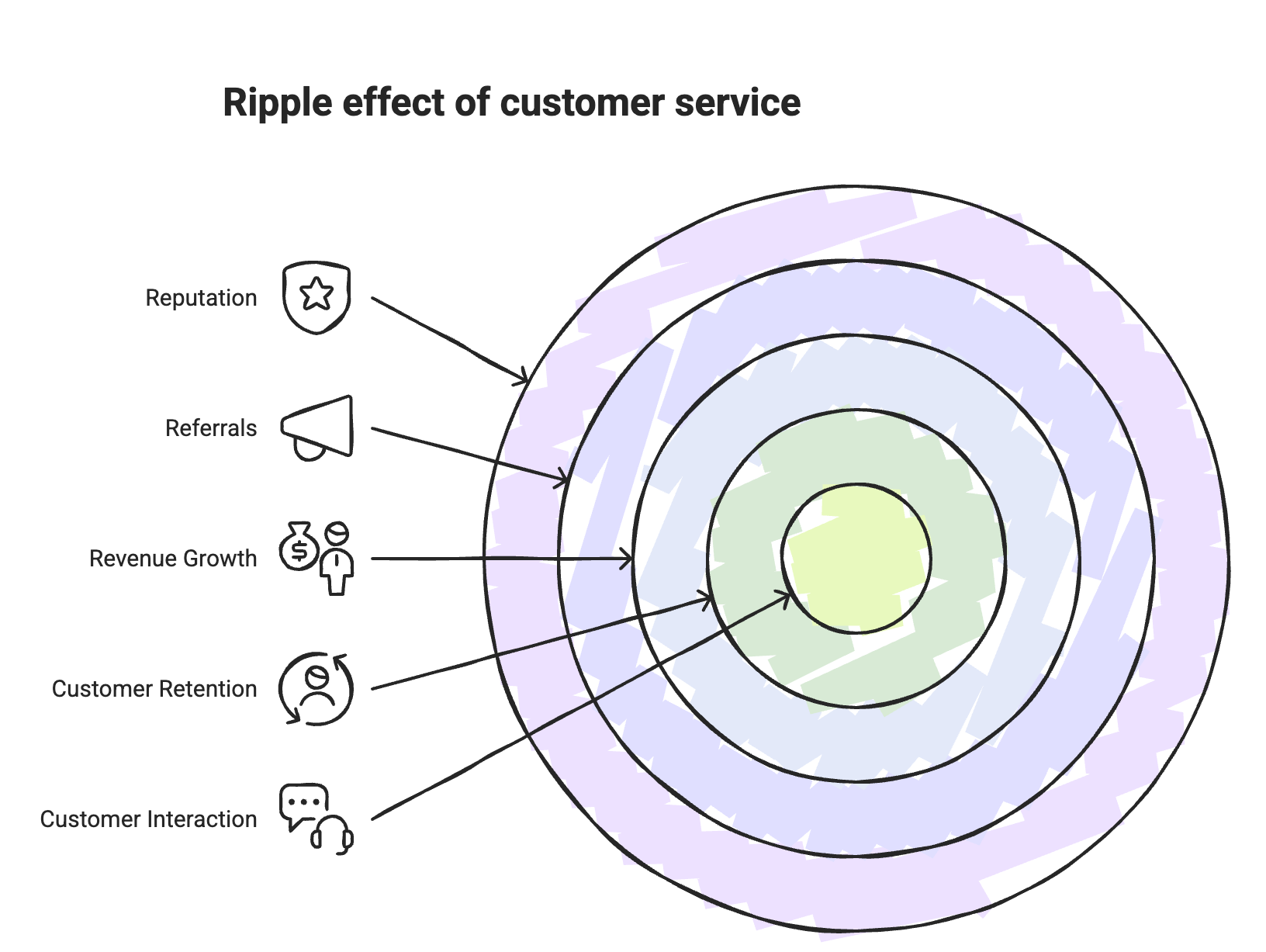
Strategic customer service approaches for 2025
With customers willing to shell out extra cash for great experiences, your service strategy isn't just nice to have—it's your ticket to revenue growth!
As we enter 2025, forward-thinking companies are completely reimagining how they interact with customers. They're moving beyond the old-school "answer the phone and solve problems" approach toward sophisticated strategies that build loyalty and drive serious growth.
Proactive vs. reactive service models
Customer service has traditionally been like a firefighter—waiting for the alarm before rushing to put out flames. That's reactive service in a nutshell. Proactive service, though? It's more like having a fire prevention system that spots smoke before the fire even starts.
According to recent data, proactive support is quickly becoming the expected standard rather than a nice bonus. This approach uses predictive analytics and AI to spot potential problems based on how customers behave.
Imagine your system automatically reminding customers about upcoming payment deadlines or suggesting account tweaks for better savings. Smart, right? This strategy doesn't just make customers happy—it cuts your support costs by stopping small issues from growing into expensive problems.
Personalization at scale
Remember those mom-and-pop shops where the owner knew your name, your kids' names, and exactly how you liked your coffee? Personalization at scale is that same feeling, delivered to millions of customers simultaneously.
It analyzes mountains of customer data to create experiences tailored to specific needs and preferences. The result? Customers feel seen and understood, boosting engagement, satisfaction, and loyalty.
The companies crushing it in this area build what I call a "personalization engine." They create a data foundation all teams can access, build content systems that assemble personalized experiences on the fly, and orchestrate touchpoints throughout the entire customer journey.
They use smart decision tools to determine which customers should get which messages through which channels for maximum impact. This isn't just being friendly—it's strategic relationship-building at scale!
Building a customer-centric culture
Building a truly customer-centric culture isn't about slogans on the wall—it starts at the top, with a clear purpose that flows through every level of your organization.
The companies that nail this focus on:
- Open and honest workplace communication (no hiding bad news!)
- Leaders who actually connect with employees
- Inspiring teams to own solutions rather than pass the buck
- Creating work environments that actually make sense for employees
When everyone from the CEO to the newest support agent wakes up thinking about customers first, you've created something competitors can't easily copy. In a world where business models get replicated overnight, culture becomes your ultimate competitive advantage.
Data-driven service strategies
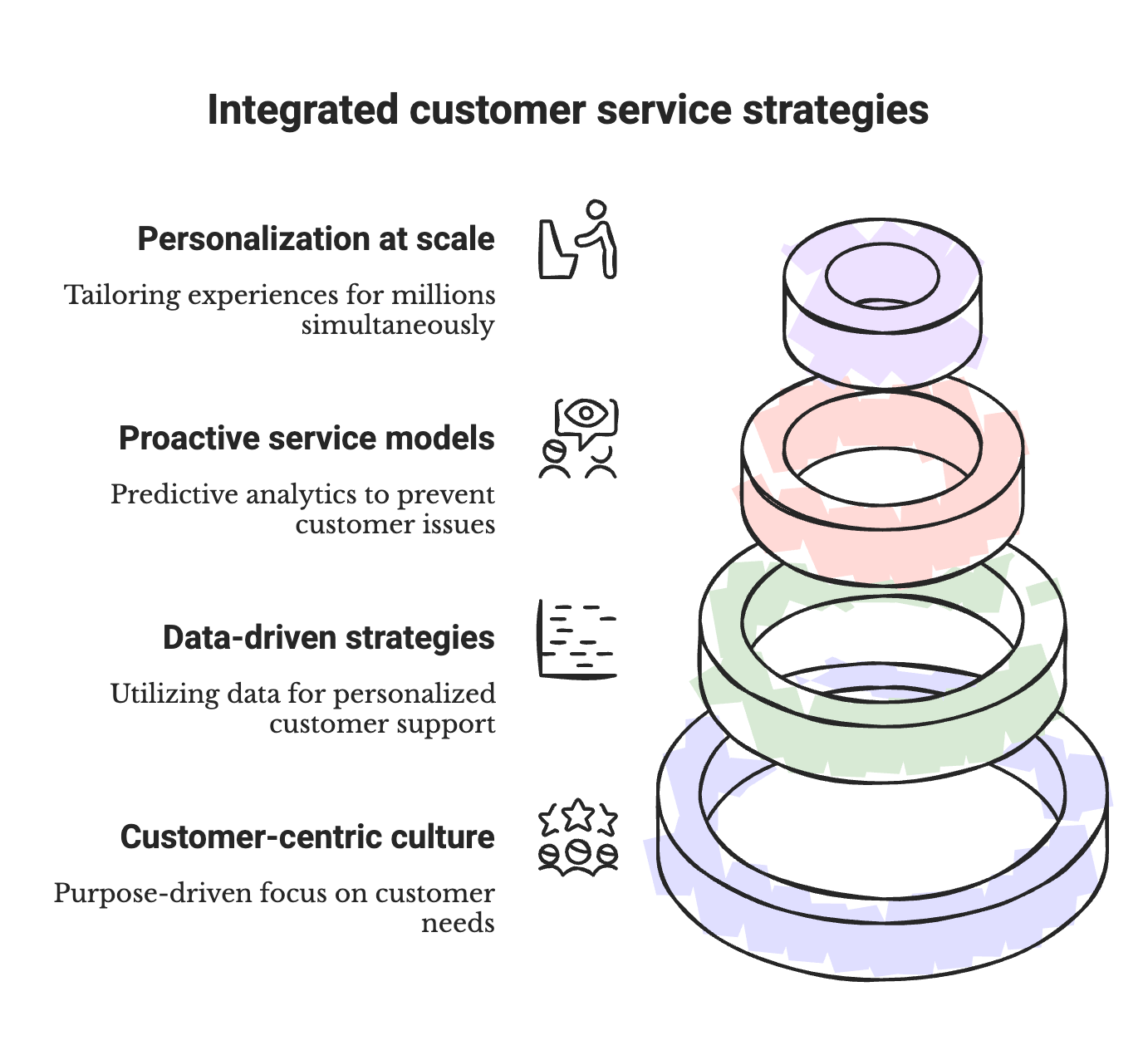
Data-driven customer service transforms support from a money pit into a growth machine. By breaking down those annoying data silos and giving support teams the full customer picture, your agents can tailor their approach with scary accuracy.
Imagine your customer data platform suggesting the perfect next action to an agent, including new features or add-on products that genuinely help customers achieve their goals. The payoff? Greater personalization, the ability to predict issues before they happen, and much better service recovery when things do go wrong.
The bottom line? Companies that make decisions based on customer service data see massive increases in customer retention.
Balancing human touch and technology in customer service
Imagine reaching out to a company with a complex issue and being seamlessly guided from an AI assistant to a knowledgeable human agent who already knows your problem. This isn't futuristic thinking—it's the balanced approach to customer service that leading companies are implementing today.
Remember the last time you were stuck in a customer service loop, repeating your information to three different people? Maddening, wasn't it? In 2025, that frustration is becoming extinct as companies master the delicate dance between technology and human connection.
Think of it as a relay race where the AI handles the first leg, gathering information at lightning speed, then smoothly passes the baton to a human who brings empathy and complex problem-solving to the finish line. No dropped batons. No awkward handoffs. Just a seamless experience that leaves customers thinking, "Wow, that was surprisingly painless!"
The truth is, customers don't actually care if they're talking to a bot or a person—they care about getting their problem solved quickly and feeling valued in the process. That's the secret sauce of modern customer service.
AI handles the repetitive stuff while humans focus on what they do best—connecting, understanding, and creating those memorable moments that turn frustrated customers into loyal fans.
But here's where most companies get it wrong: they implement technology without considering the human element, or they rely too heavily on human agents for tasks that technology could handle in seconds. Both approaches leave money on the table and customers pulling their hair out.
The companies crushing it in 2025 aren't choosing between humans OR technology—they're figuring out how humans AND technology work together to create experiences that feel both efficient and personal. That's the golden ticket in customer service today.
Measuring customer service success beyond CSAT
Customer Satisfaction (CSAT) scores might tell you what customers think after an interaction, but they're just the tip of the iceberg when it comes to measuring true service success.
Behind every exceptional customer experience lies a set of sophisticated metrics that capture real business impact. Research shows that businesses tracking advanced service metrics are 40% more likely to achieve significant revenue growth. That's nearly half your competitors pulling ahead just by measuring the right things!
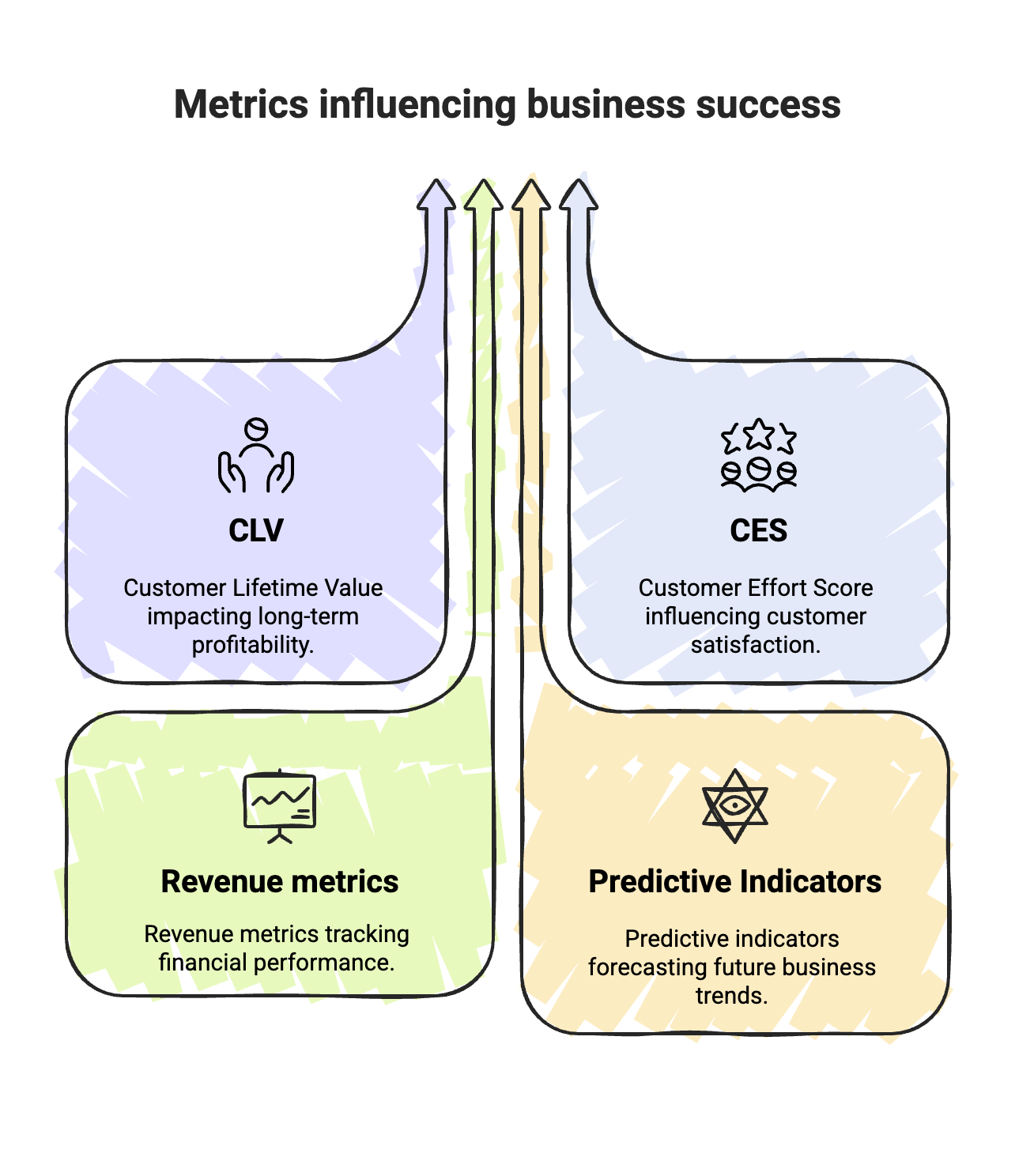
Customer lifetime value metrics
Customer lifetime value (CLV) isn't just another fancy acronym—it's the total worth a customer brings to your business throughout your entire relationship. Unlike CSAT, which just promises satisfaction might lead to money, CLV is directly tied to cold, hard cash. It tells you exactly which customers are your golden geese.
The math isn't rocket science: Customer revenue per year × Duration of relationship in years – Total acquisition and service costs. Simple, right?
CLV helps you:
- Develop targeted acquisition and retention strategies (no more throwing money at the wrong prospects!)
- Spot early warning signs that valuable customers might be heading for the exit
- Identify your VIP customer segments worth rolling out the red carpet for
Want sustainable profits? Maintain a healthy 3:1 ratio between CLV and customer acquisition cost (CAC). That's your secret formula for building a business that doesn't just grow but thrives for the long haul.
Effort reduction measurements
Customer Effort Score (CES) measures how much sweat your customers break just to get their issues resolved. Here's the kicker—CES is 40% more accurate at predicting customer loyalty than satisfaction alone. People might say they're satisfied, but if they had to climb a mountain to get help, they're still heading to your competitor next time!
By making things easier for customers, you'll see:
- Higher repurchase rates
- Lower service costs
- Improved employee retention
Revenue impact indicators
Smart companies don't just track fuzzy feelings—they follow the money. They monitor how service directly impacts dollars and cents through:
- Repurchase rates after service interactions (did they come back or run away?)
- Cross-selling and up-selling success from support contacts (did that helpful agent turn a problem into an opportunity?)
- Support-influenced expansion revenue (did solving that issue lead to bigger contracts?)
With businesses facing potential revenue losses of $3.7 trillion globally from poor customer service, tracking these financial impacts isn't just nice—it's necessary! It gives you the ammunition you need when fighting for service improvement budgets.
Predictive service analytics
Predictive analytics is like having a crystal ball for customer behavior. It uses historical data to spot trends and opportunities before they happen. Instead of being surprised when customers leave, you can:
- Flag at-risk customers before they even think about canceling
- Anticipate customer needs and reach out before they have to ask
- Staff your team perfectly during crazy-busy periods
Through these predictive superpowers, you can create personalized experiences for millions of customers by analyzing their data to understand what makes them tick. It's like having a million personal shoppers without the million-dollar salary bill!
Conclusion
Customer service has evolved far beyond answering tickets and solving problems. It's become a strategic powerhouse that drives serious business growth. Your approach to customer service directly impacts your bottom line - with research showing that even a tiny 5% increase in retention rates can boost profits by a staggering 25-95%. Isn't that mind-blowing?
A small improvement in keeping customers happy translates to massive profit growth!
Modern customer service in 2025 requires a delicate balance. Think of it as a dance between human warmth and technological efficiency. While AI handles the repetitive stuff (like tracking orders and answering FAQs), human agents bring the magic for complex issues and emotional situations.
Your customers don't care about the technology behind the scenes - they care about getting their problems solved quickly and feeling valued in the process.
Success measurement has grown up, too. Those basic satisfaction scores? They're just the starting point. Customer lifetime value shows you which customers are worth their weight in gold.
Effort reduction metrics reveal whether you're making customers climb mountains just to get help. And predictive analytics gives you that crystal ball to spot issues before they explode. Together, these metrics paint the complete picture of service that actually drives growth.
The companies crushing it in 2025 aren't just answering questions - they're creating experiences that turn frustrated customers into raving fans. They're personalizing at scale, being proactive instead of reactive, and making every decision based on solid customer data.
Remember - your customer service isn't just a department tucked away in some corner of your organization. It's the face of your brand. It's what customers remember long after they've forgotten your fancy marketing campaigns. And ultimately, it's what will determine whether your business merely survives or absolutely thrives in the years ahead.
Quick Summary: What is Customer Service in 2025?
- Customer service = business growth
It’s not just about fixing issues—great service now builds loyalty and boosts revenue. - Expectations are sky-high
61% of customers leave after just one bad experience. And they’ll tell the world about it. - Modern definition
Helping customers before, during, and after a purchase—through people, tech, or both. - What makes service great in 2025?
- Fast replies
- Friendly, human-like interactions
- Help available on all channels (chat, email, socials)
- Smart self-service options
- Proactive support (fix issues before they explode)
- Customer service vs. customer experience
Service is one part. Experience is the whole journey. Both matter—but service is where loyalty is won or lost. - Bad service is expensive
Businesses risk losing $3.7 trillion globally due to poor service. - Top strategies for 2025
- Be proactive, not just reactive
- Personalize at scale using data
- Blend AI with human agents
- Build a culture that puts customers first
- Use data to predict needs and solve faster
- Smarter ways to measure success
Go beyond CSAT. Track: - Customer Lifetime Value (CLV)
- Customer Effort Score (CES)
- Revenue from service interactions
- Predictive analytics to stay ahead
Frequently Asked Questions
Customer service in 2025 is expected to become more proactive, leveraging AI-driven automation and advanced personalization. Companies will focus on providing omnichannel experiences while balancing human empathy with technological efficiency. The emphasis will be on anticipating customer needs and offering solutions before problems arise.
AI will play a crucial role in handling routine inquiries, automating workflows, and providing predictive analytics. It will enable chatbots and virtual assistants to manage basic troubleshooting, freeing up human agents for complex issues. AI will also help in personalizing interactions and offering data-driven insights to improve the overall customer experience.
Customer service is becoming a strategic imperative due to its direct impact on revenue and retention. Excellent service can increase customer loyalty, boost profits, and serve as a key competitive differentiator. Poor service, on the other hand, can lead to significant financial losses and damage to a company's reputation.
Businesses can measure customer service success using metrics such as Customer Lifetime Value (CLV), Customer Effort Score (CES), and revenue impact indicators. Additionally, predictive service analytics can help forecast customer behavior and identify opportunities for improvement. These metrics provide a more comprehensive view of service effectiveness than traditional satisfaction scores alone.
Companies can balance human touch and technology by creating seamless handoffs between AI-powered systems and human agents. While AI can handle routine tasks and provide instant responses, human agents should be available for complex issues requiring empathy and creative problem-solving.
The key is to use technology to enhance, not replace, human interactions, ensuring customers receive personalized and efficient service.
